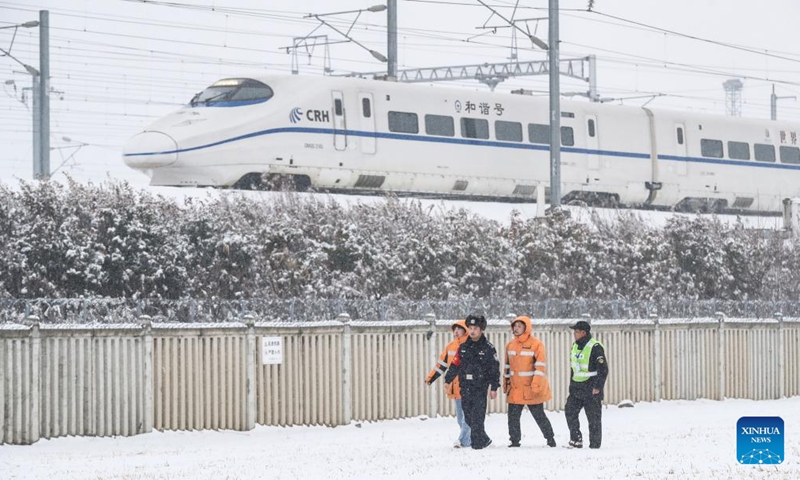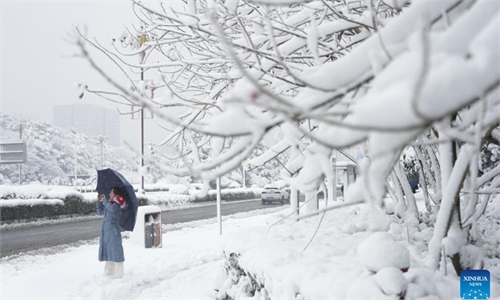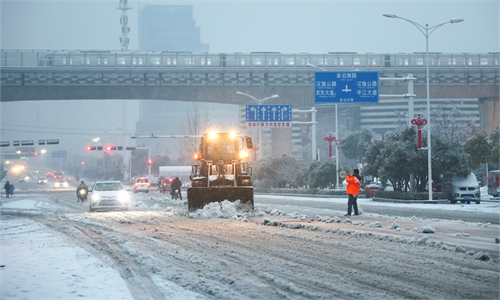
Policemen and high-speed railway infrastructure workers patrol the railway in Huai'an City, east China's Jiangsu Province, Feb. 4, 2024. Heavy snowfall has hit some areas of central and eastern China since Wednesday, leading to transport disruption amid the ongoing Spring Festival travel rush. (Photo by Zhao Qirui/Xinhua)
When the Spring Festival travel rush of 2024 coincided with a wave of severe blizzards and freezing rain weather, the worst since 2009, key transportation hubs like Central China's Hubei and Henan provinces are facing formidable challenges.
The extreme weather swept through central and southern areas of China during the early peak days of the chunyun, or Spring Festival travel rush, posing huge challenges to rail and highway transportation, but the solidarity and resilience of Chinese people, as well as the proactive and prompt government response, have helped clear the road home for millions of travelers.
Bumpy road home
Spring Festival is the time when Chinese people set off for their hometowns and family reunions. An estimated 9 billion passenger trips will be made during the 2024 chunyun. Yet this year's journey seemed exceptionally long and arduous.
Many people were stranded for days at train stations or on the highways due to freezing rain and snow. But heartwarming stories have also unfolded along their way. Stranded people supported each other, nearby villagers offered assistance and local authorities responded proactively and promptly, highlighting the strength and cohesion of Chinese society.
After continuous snow and icy rain for days, Central China's Henan, Hubei and Hunan provinces, as well as East China's Shandong, Anhui and Jiangsu provinces, had accumulated snow depths ranging from 5 to 15 centimeters, according to media reports. They are also populous areas where major transportation arteries cross.
It is expected that the rainy, snowy and freezing weather in these areas will continue until Wednesday, according to the China Meteorological Administration.
The ice rain froze on overhead wires, obstructing power supply of the trains; snow and ice on rail tracks force the high-speed trains to run at lower speeds for safety reasons. Due to the adverse weather conditions, hundreds of trains were delayed or canceled.
This has left a significant number of passengers stranded at main railway hubs, including Wuhan, capital city of Hubei, Guangzhou, capital of South China's Guangdong Province, as well as Beijing and Shanghai, from where large numbers of workers are attempting to head home for the Chinese Lunar New Year holidays.
Such rare scenes prompted many to recall the hard battle against the chaotic weather during the Spring Festival of 2008 when hundreds and thousands of passengers were stranded at Guangzhou railway station due to severe snowstorms.
Fortunately, this year turns out to be different from what people have had in their mind about the past experiences.
Chen, who works in Wuhan, finally arrived in her hometown Yichang, 325 kilometers away, after a drive of 20 hours on the "very slippery" highway. The rain and snow froze on the road, making it difficult and dangerous for vehicles to move, Chen told the Global Times on Tuesday.
There were more vehicles and accidents due to high holiday traffic volumes, and many of the emergency lanes were blocked. Traffic authorities cleared the snow and spread salt to accelerate snow melting, Chen said.
This was the first time Chen experienced such a scene. When she and others were stuck on the highway, villagers cooked eggs for them and brought oranges, sweet potatoes and snacks, all free of charge. "We were really touched," Chen said gratefully.
Another woman surnamed Fu, who is still stuck in Jingzhou in Hubei, posted on Tuesday morning on her WeChat account that vehicles along an 80-kilometer section of the highway where she and her family were stuck had been kept motionless for 10 hours.
Their vehicle's starter motor broke down. But fortunately, some friends stuck behind them helped get it running again, Fu told the Global Times on Tuesday.
Along the way, Fu's family encountered many kind-hearted fellow drivers who helped push their car, and they also saw parents ask for hot water as their babies were in need of formula milk.
An official from Suizhou, another city in Hubei, arrived at the highway toll booth with a pot and a small gas cylinder to cook noodles for stranded passengers, which drew public attention on social media.
All-out efforts
Since January, many parts of the country have experienced severe low-temperature rain, snow and freezing disasters, with snow depths in some areas exceeding 30 centimeters. This has posed serious challenges for the Spring Festival travel rush.
The Ministry of Finance and the Ministry of Transport allocated 141 million yuan ($19.84 million) on Tuesday to support ice and snow removal efforts on highways in 11 provinces and municipalities, including Hunan, Hubei and Chongqing.
Peng Xuewen, an official with the Hubei provincial emergency management department, told China Central Television (CCTV) on Monday that currently, there are approximately 180 kilometers of slow-moving sections on highways throughout Hubei, affecting nine different expressways and involving roughly 4,000 vehicles.
The traffic congestion on the highways is gradually improving. Hubei has a total of 52 expressways with 462 toll stations, and during the peak traffic period on Sunday, there were restrictions in place at 296 toll stations. As of Monday, this number has been reduced by 201, with 95 toll stations still under restrictions, Peng said.
China Railway also noted on Monday that at present, railway operations adversely affected by the weather are gradually returning to normal.
Central authorities have arranged cross-provincial ice and snow removal operations with 10 teams comprising of 500 personnel, and 19 helicopters from aviation rescue forces. With central government instructions, Anhui and Hubei authorities also mobilized 20 rescue teams comprising 1,600 personnel from local state-owned enterprises.
Vice Minister of Commerce Sheng Qiuping told a press conference on Tuesday that to cope with the abnormal weather, the ministry held meetings and enhanced coordination with meteorological, transportation and other departments to make early preparations for food and other necessities, and assessed the reserves of central and local governments in relevant regions to ensure timely releases to markets.
This round of extreme weather is a combination of heavy snowfall and frozen rain, which makes roads unusually wet and difficult to clear, Ma Jun, director of the Beijing-based Institute of Public and Environmental Affairs, told the Global Times on Tuesday.
What exacerbates the situation is its occurrence during the chunyun and in traffic-intense provinces and regions, Ma said.
Given the increasing occurrence of extreme weather events caused by climate change in recent years, "how to improve extreme weather forecasts and early warning systems is also a topic that needs to be further studied," Ma noted.
Experts also called for more efforts to optimize the country's emergency response mechanism, particularly local governments' capability of dealing with rarely seen extreme weather.



